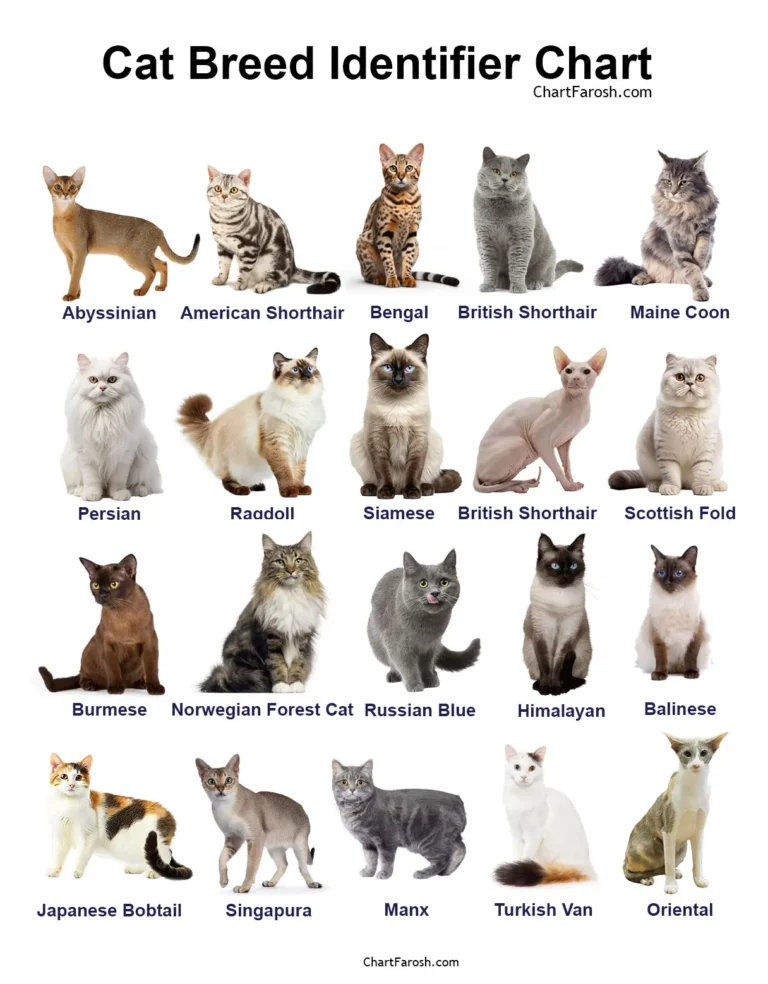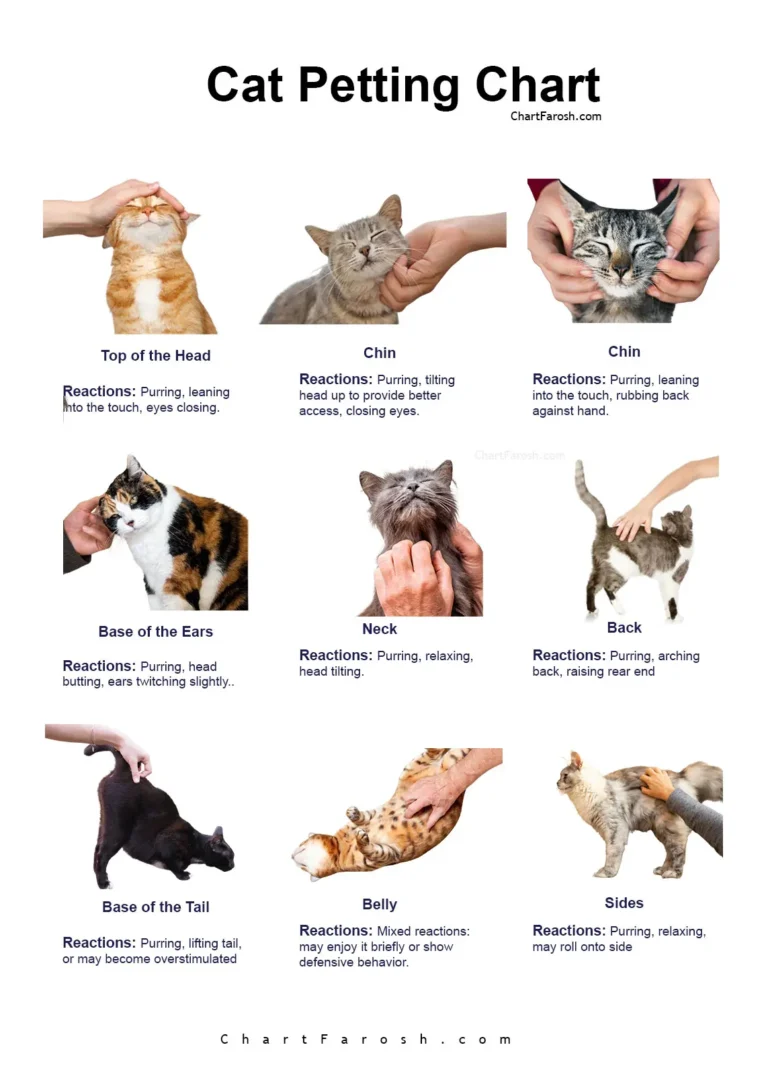Cat Markings Chart
How often do you differentiate cats based on their markings? These markings are unique features that help differentiate between breeds and highlight their origins. Cat markings have fascinated humans for centuries. Historically, many cultures highlighted these markings in their art and literature. The ancient Egyptians revered cats and often depicted their intricate markings in their art.
As domesticated cats spread worldwide, enthusiasts started documenting and studying their markings. This led to the development of detailed cat marking charts. These charts classify patterns and colors, offering valuable information for cat owners, breeders, and enthusiasts.
Read on as we discuss cat markings and learn everything you need to know about them.

Table of Contents
Cat Markings Chart
The cat markings chart helps to learn more about the breed and its historical origin. The diverse and intricate patterns found in feline coats are an essential tool for anyone interested in them. These charts help identify various markings and provide insights into the genetics and history behind these patterns. One key use of a cat markings chart is in breeding programs.
These charts are used by breeders to forecast the arrival of kittens and guarantee the persistence of particular qualities within a breed. By knowing the genetic foundation of markings, breeders can choose which cats to couple to develop or maintain preferred patterns.
Researchers looking into feline genetics and veterinarians can both benefit from these charts. They aid in determining hereditary disorders connected to particular coat hues and patterns. For instance, the likelihood of deafness in white cats with blue eyes can be monitored and controlled by meticulous breeding methods guided by a marks chart.
In addition, cat marking charts are educational tools for pet owners and cat enthusiasts. They provide a visual guide to the various patterns and colors that can occur in cats, from the common tabby to the rare and sought-after lilac. Understanding these patterns can deepen an owner’s appreciation for their pet and enhance their knowledge of feline genetics and breeding.
| Marking Type | Description | Example Breeds |
|---|---|---|
| Solid (Self) | A single, uniform color without any markings. | British Shorthair, Russian Blue, Bombay |
| Tabby | Distinctive stripes, spots, or swirls, often with an “M” shape on the forehead. | Maine Coon, American Shorthair, Bengal |
| Mackerel Tabby | Vertical, narrow stripes running parallel along the cat’s sides. | American Shorthair, Scottish Fold |
| Classic Tabby | Bold, swirling patterns resembling a marble cake. | American Shorthair, British Shorthair |
| Spotted Tabby | Spots rather than stripes, sometimes resembling a wildcat. | Bengal, Egyptian Mau |
| Ticked Tabby | Each hair is banded with multiple colors, giving a salt-and-pepper appearance. | Abyssinian, Somali |
| Bicolor | White fur combined with another color (e.g., black and white, orange and white). | American Shorthair, Turkish Van |
| Tuxedo | Black and white markings resembling a tuxedo suit. | Domestic Shorthair, British Shorthair |
| Van | Mostly white with color on the head and tail. | Turkish Van, Turkish Angora |
| Harlequin | Predominantly white with large patches of another color. | Persian, Ragdoll |
| Calico | White with large patches of black and orange (or grey and cream). | Domestic Shorthair, Japanese Bobtail |
| Tortoiseshell | A mix of black and orange (or grey and cream) blended together. | Domestic Shorthair, Persian |
| Torbie | A mix of tortoiseshell and tabby patterns. | Maine Coon, Domestic Shorthair |
| Colorpoint | Darker colors on the ears, face, paws, and tail, with a lighter body color. | Siamese, Himalayan, Ragdoll |
| Lynx Point | Colorpoint pattern with tabby striping on the darker points. | Siamese, Balinese, Ragdoll |
| Smoke | Fur with white or light undercoat and darker tips. | Persian, British Shorthair |
| Shaded | Hair is lighter at the base and darker at the tip, creating a shaded appearance. | Chinchilla Persian, Burmilla |
| Shell (Chinchilla) | Very light undercoat with only the tips of the fur color, giving a silvery look. | Chinchilla Persian, British Shorthair |
What is the Rarest Pattern on a Cat?
The “lilac” or “lavender” hue is the rarest pattern on a cat. This pattern, which results in a delicate, almost pastel shade of gray with a pinkish tint, is caused by a hereditary dilution of hues. Because both parents must inherit the recessive gene responsible for this distinctive pigmentation, the lilac pattern is extremely unusual.
Lilac cats can be distinguished from other patterns by their lavender-colored noses and paw pads. Breeders and cat fans particularly value this uncommon hue for its beauty and the genetic challenge it poses. Thanks to the dedicated efforts of breeders who have strived to propagate this delicate and distinctive pattern, breeds like the Siamese and British Shorthair are known to exhibit this rare pattern more frequently.
Also read: Cat Breed Identifier Chart
Female Cat Markings
Female cats frequently exhibit unique markings, especially in patterns like tortoiseshell and calico. This is due to their genetic makeup, which includes two X chromosomes. Each X chromosome can carry a different color gene, allowing for the simultaneous expression of both black and orange fur, resulting in striking tortoiseshell or calico patterns.
In contrast, male cats, having one X and one Y chromosome, typically do not display these patterns unless they possess an extra X chromosome, a condition known as Klinefelter syndrome. This genetic peculiarity explains why almost all tortoiseshell and calico cats are female.
These patterns are not just visually distinctive but also provide insights into the genetic mechanisms that drive coat color and pattern development in cats.
Understanding these female-specific markings helps in identifying the gender of a cat at a glance and provides breeders with crucial information for planning their breeding programs. For instance, breeders looking to produce tortoiseshell or calico kittens must ensure that the breeding pair includes a female capable of passing on these unique traits.
Also read: Cat Tail Meanings Chart
Role of Genetics in the Markings of a Cat
Genetics plays a fundamental role in determining a cat’s markings. The variety of patterns seen in cats results from the interaction of different genes. For example, the Agouti gene is responsible for the tabby pattern and can express itself in several ways, such as mackerel, classic, spotted, and ticked tabby patterns.
The S gene controls the distribution of white fur, resulting in various white patterns like bicolor or van. Cats with the S gene may have anything from a small white spot to almost entirely white fur. The degree of white spotting can vary significantly, even among kittens from the same litter.
The dilution gene affects the intensity of colors, leading to softer hues like blue (gray) or lilac. A black cat with the dilution gene will appear blue, and a red cat will appear cream. These genetic interactions create the vast array of coat colors and patterns seen in cats today.
Breeders use this genetic knowledge to produce kittens with specific markings. By understanding how different genes interact, they can predict the likelihood of certain patterns appearing in offspring. This selective breeding ensures the propagation of desirable traits, allowing breeders to meet the preferences of cat enthusiasts and maintain the diversity of feline coat patterns.
Also read: Cat Hair Length Chart
Conclusion
The study of cat markings offers fascinating insights into feline genetics and aesthetics. A detailed cat markings chart helps to understand the different markings. Each pattern has its own genetic story, from the rare lilac pattern to the distinctive markings of female cats. Understanding these patterns enhances our appreciation of cats and aids in responsible breeding practices.
Selective breeding practices ensure the continuation of specific traits and patterns, meeting the demands of cat enthusiasts and maintaining the diversity of feline coats. These practices are not just about aesthetics but also involve ensuring future generations’ health and genetic viability.
So, next time you buy a cat, get this chart to understand its breed better.






